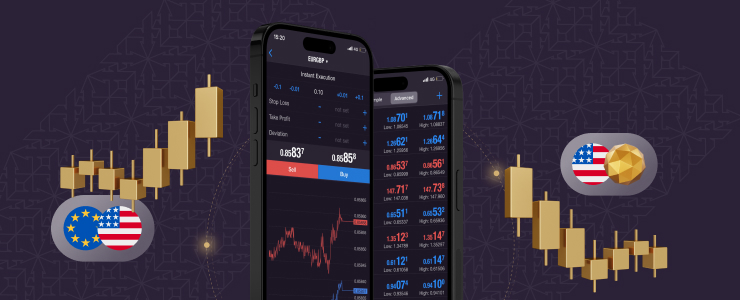Les traders sur le marché des changes savent que de nombreux facteurs complexes peuvent influencer une seule devise à tout moment. La valeur d’une devise résulte d’une lutte permanente entre la macroéconomie, les politiques des banques centrales, les risques politiques et le sentiment des investisseurs. Pour les traders chevronnés et les investisseurs institutionnels, l’évolution des paires de devises est plus complexe que le simple suivi des indicateurs économiques ou la réaction aux événements.
Cela nécessite une combinaison d’analyses fondamentales et d’analyses du sentiment du marché.
Les données et les perceptions façonnent le sentiment du marché. À son tour, le sentiment influe sur les flux et la volatilité, amplifiant ou atténuant parfois l’impact d’une publication économique. Par exemple, une annonce restrictive de la banque centrale peut ne pas faire monter la valeur d’une devise si les acteurs du marché l’ont déjà intégrée dans leurs anticipations. Elle n’est alors plus une surprise. À l’inverse, des indicateurs économiques neutres peuvent déclencher des mouvements brusques lorsqu’ils dépassent ou ne répondent pas aux attentes de manière inattendue.
En termes simples, l’activité du marché des changes n’est pas le résultat d’un événement, mais le résultat de la façon dont les acteurs du marché perçoivent cet événement. C’est pourquoi nous examinerons comment l’interaction entre le sentiment et les fondamentaux influence les mouvements du marché.

Le pouvoir de l’analyse fondamentale sur le marché des changes
L’analyse fondamentale du Forex se concentre sur la devise d’un pays en termes de santé économique, d’influences géopolitiques et de valeur de sa devise. Elle s’apparente à l’analyse des états financiers d’une entreprise avant d’acheter ses actions, mais elle s’effectue au niveau d’un pays, en évaluant sa santé économique.
Taux d’intérêt
Un élément central de l’analyse fondamentale est le taux d’intérêt. Lorsqu’une banque centrale comme la FED ou la BCE augmente ses taux, la monnaie du pays concerné s’apprécie généralement. Cela s’explique par le fait que les investisseurs étrangers recherchent de meilleurs rendements, ce qui augmente la demande pour cette devise sur le marché des changes. Une baisse des taux affaiblit toutefois la devise, car elle indique des difficultés économiques ou une politique monétaire laxiste.
Inflation
L’inflation est également un facteur important qui influence l’analyse fondamentale. Lorsque le taux d’inflation est élevé, il augmente le taux d’érosion du pouvoir d’achat des clients, ce qui, à long terme, diminue la valeur d’une monnaie. Cependant, une banque centrale peut augmenter les taux d’intérêt pour contrôler l’inflation et soutenir la monnaie à court terme. Il est donc important d’analyser les données sur l’inflation et les réactions attendues des banques centrales.
PIB
La croissance du PIB est un autre élément essentiel de cette interaction complexe entre les forces du marché. Une économie en expansion est généralement synonyme d’augmentation de la consommation, des opportunités d’emploi et des investissements des entreprises. Tous ces facteurs sont susceptibles de soutenir une devise à long terme. Cependant, si la croissance stagne ou diminue, les traders ont tendance à réagir rapidement, anticipant une baisse des rendements dans ce pays.
Chiffres de l’emploi
Les chiffres de l’emploi sont un indicateur avancé du bien-être économique. Un rapport tel que celui sur les emplois non agricoles aux États-Unis (NFP) peut potentiellement bouleverser le marché. Un rapport sur l’emploi solide suggère généralement que l’économie se porte bien, ce qui est positif pour la devise. Un rapport faible peut signaler un ralentissement économique et est mauvais pour la devise.
Les balances commerciales ralentissent l’économie et nuisent à la monnaie.
Les balances commerciales jouent également un rôle. Les pays qui exportent plus qu’ils n’importent verront leur monnaie s’apprécier, car les acheteurs étrangers devront payer leurs importations dans la monnaie locale. Un déficit commercial important et durable peut toutefois peser sur les perspectives à long terme d’une monnaie.
Changements de politique
Et puis, bien sûr, il y a la politique. Les changements politiques, les guerres commerciales et les tensions nationales peuvent tous avoir des effets dévastateurs sur les marchés. En période d’incertitude, les traders transfèrent souvent leurs couvertures vers des devises « refuges » telles que le dollar américain, le yen japonais ou le franc suisse.

Le côté émotionnel : le sentiment du marché Forex
Alors que l’analyse est une réalité dure et froide, le sentiment est plus émotionnel et réactionnaire. Il s’agit de l’humeur collective des investisseurs et des traders face à ce qui se passe aujourd’hui et à ce qui pourrait se passer demain.
Parfois, le sentiment va dans le sens des fondamentaux. Une économie saine entraîne des prévisions positives, et la devise s’apprécie en conséquence. Mais parfois, le sentiment l’emporte complètement sur les chiffres.
Réfléchissez-y : même si les chiffres économiques indiquent qu’une devise va s’apprécier, l’anxiété ou le scepticisme des marchés peuvent faire basculer la tendance. C’est pourquoi il est primordial de comprendre le sentiment des marchés, en particulier pour les traders à court terme.
Les gros titres, les commentaires des médias et les prévisions économiques peuvent influencer le sentiment. Une publication sur les réseaux sociaux d’un homme politique ou une déclaration surprise d’un banquier central peuvent changer l’humeur du marché en quelques secondes. Pensez aux publications du président Donald Trump sur X ou aux commentaires du président de la Fed, Jerome Powell. Leurs paroles peuvent déplacer des montagnes.
La tolérance au risque à l’échelle mondiale joue également un rôle colossal. Lorsque les investisseurs sont optimistes, ils recherchent des rendements plus élevés en investissant dans des devises plus risquées comme le dollar australien ou néo-zélandais. Cependant, lorsque les investisseurs sont inquiets en raison d’une guerre, d’une pandémie ou d’une crise bancaire, ils se réfugient dans des actifs plus sûrs, ce qui stimule la demande pour le dollar américain ou le yen japonais.
Le positionnement spéculatif est un autre facteur influant sur le sentiment. Lorsque tout le monde est déjà fortement positionné à l’achat ou à la vente dans une certaine direction, il se peut qu’un renversement de tendance se produise. Le rapport COT (Commitment of Traders) est un outil qui peut fournir des indications utiles pour savoir si une transaction sera « surchargée » ou non.
Même le ton adopté par la banque centrale peut influencer les devises. Un ton agressif suggère une hausse de la devise, tandis qu’un ton conciliant peut l’affaiblir.
Comment les fondamentaux et le sentiment interagissent sur le marché des changes
L’une des leçons les plus importantes pour tout trader sur le marché des changes est que les marchés ne bougent pas en fonction des données. Ils bougent en fonction de ce que les traders pensent de ces données. Et c’est là que le sentiment entre en jeu.
Prenons un exemple. Supposons que la Banque centrale européenne augmente ses taux d’intérêt pour lutter contre la hausse de l’inflation. Sur le papier, c’est une bonne nouvelle pour l’euro. Mais supposons que le marché estime que l’économie de la zone euro est trop fragile pour supporter des taux plus élevés. Supposons que les investisseurs pensent que cette hausse entraînera une récession. Dans ce cas, malgré la mesure « restrictive » sous-jacente, le sentiment pourrait en réalité rester négatif et l’euro pourrait chuter.
C’est pourquoi les traders expérimentés ne se contentent pas de jeter un coup d’œil aux chiffres du haut de la page. Ils se posent les questions suivantes : qu’est-ce que cela nous apprend sur les attentes du marché ? Comment le trader peut-il réagir émotionnellement ? La nouvelle est-elle déjà prise en compte dans les cours ?
Dans la plupart des cas, le sentiment exagère les fluctuations à court terme. Mais à long terme, les fondamentaux reprennent le dessus. Une économie faible ne peut pas contenir indéfiniment le sentiment du marché, et des fondamentaux solides poussent généralement une devise à la hausse à long terme, mais lentement.
Rester informé : les outils du trader moderne
Pour mettre tout cela en perspective, les traders utilisent toutefois une combinaison de ressources et d’outils. Les calendriers économiques permettent de suivre les publications de données à venir, telles que le PIB, l’inflation ou les décisions relatives aux taux d’intérêt. De nombreux courtiers proposent des calendriers en temps réel directement sur leurs plateformes.
La lecture des communiqués de la banque centrale, des conférences de presse et des procès-verbaux des réunions peut révéler le point de vue des décideurs politiques sur l’économie. Elle donne également des indications sur les mesures qui pourraient être prises prochainement.
Pour connaître l’état du sentiment, il est utile de suivre l’actualité financière et les commentaires des analystes. Il en va de même pour les indicateurs de sentiment, tels que la position des traders sur différentes paires de devises. L’indice VIX (ou « indice de la peur ») peut également donner une idée du niveau de volatilité auquel s’attendent les traders dans un avenir immédiat.
En fin de compte, la prospérité dans le trading forex dépend de la volonté de rester curieux, de se tenir informé et de comprendre comment analyser à la fois la réalité et le sentiment du marché.

Points clés à retenir
Le marché des changes est une intégration de divers faits et chiffres, et le marché des changes en lui-même est une intégration de faits et chiffres ainsi que du sentiment. L’analyse fondamentale aborde le « pourquoi » de la force et de la faiblesse d’une devise, et le sentiment du marché répond au « quand » en termes de timing, d’urgence et de momentum.
En maîtrisant ces deux aspects, le trader peut tirer profit de sa capacité à anticiper les mouvements du marché, à éviter les pièges émotionnels et à tirer parti de ses positions dans le monde hautement volatil et dynamique du trading.
Que vous soyez débutant ou que vous ayez des années d’expérience dans le trading forex, maîtriser les forces qui guident le marché est une compétence complexe. L’objectif final n’est pas de suivre les tendances, mais de comprendre les principales forces qui animent le marché et d’être capable d’anticiper.
Avertissement : Ces informations ne constituent pas un conseil en investissement ni une recommandation d’investissement, mais une communication marketing.




